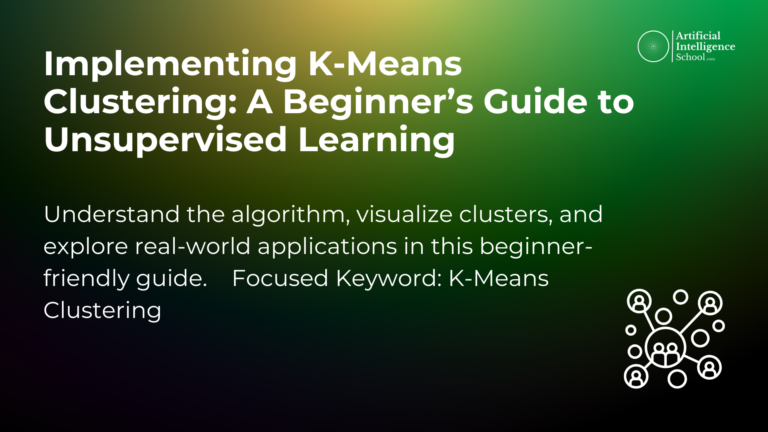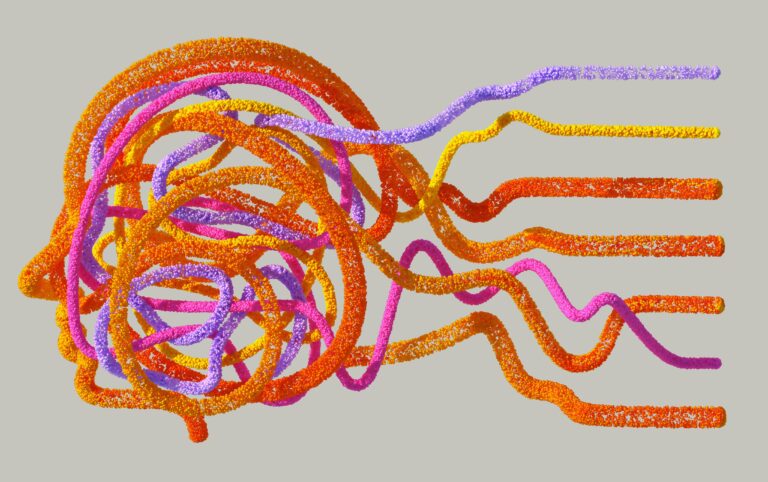Introduction to K-Means Clustering

In the vast realm of machine learning, K-means clustering stands out as a fundamental unsupervised learning algorithm. Its simplicity and effectiveness have made it a go-to choice for data scientists and analysts alike. In this comprehensive blog post, we’ll dive deep into the world of K-means clustering, exploring its inner workings, use cases, and real-life examples. Get ready to unlock the power of unsupervised learning and discover how K-means clustering can revolutionize your data analysis workflow.
What is K-Means Clustering?
At its core, K-means clustering is an algorithm that aims to partition a given dataset into K clusters. The “K” represents the number of clusters you want to form. The algorithm works by iteratively assigning each data point to the nearest cluster centroid and updating the centroids based on the mean of the assigned points. This process continues until the centroids stabilize or a maximum number of iterations is reached.
The beauty of K-means lies in its unsupervised nature. Unlike supervised learning algorithms that require labeled data, K-means can uncover hidden patterns and structures within unlabeled datasets. It relies solely on the inherent similarities and differences among the data points to form meaningful clusters.
How Does K-Means Clustering Work?
To understand the inner workings of K-means clustering, let’s break it down into simple steps:
- Initialization: The algorithm begins by randomly selecting K data points as the initial centroids for the clusters. These centroids serve as the starting points for the clustering process.
- Assignment: In this step, each data point is assigned to the nearest centroid based on a distance metric, typically Euclidean distance. The goal is to minimize the overall distance between data points and their assigned centroids.
- Update: After assigning all data points to clusters, the centroids are updated. The new centroid for each cluster is calculated as the mean of all data points assigned to that cluster. This step ensures that the centroids move towards the center of their respective clusters.
- Iteration: Steps 2 and 3 are repeated iteratively until convergence is achieved. Convergence can be defined as either a fixed number of iterations or when the centroids no longer change significantly between iterations.
By following these steps, K-means clustering gradually refines the cluster assignments and centroid positions, ultimately converging to a stable set of clusters that capture the underlying structure of the data.
Choosing the Optimal Number of Clusters (K)
One of the key challenges in K-means clustering is determining the optimal number of clusters (K) for a given dataset. While there’s no one-size-fits-all answer, several techniques can help guide your decision:
- Elbow Method: Plot the within-cluster sum of squares (WCSS) against different values of K. Look for the “elbow point” where the rate of decrease in WCSS slows down significantly. This point often indicates a good choice for K.
- Silhouette Analysis: Calculate the silhouette coefficient for each data point, which measures how well it fits into its assigned cluster compared to other clusters. Choose the K value that maximizes the average silhouette coefficient across all data points.
- Domain Knowledge: Consider the context and domain knowledge of your problem. Sometimes, the optimal number of clusters may be dictated by the specific application or business requirements.
It’s essential to experiment with different values of K and evaluate the resulting clusters using both quantitative metrics and qualitative insights to make an informed decision.
Advantages and Limitations of K-Means Clustering
K-means clustering offers several advantages that make it a popular choice:
- Simplicity: The algorithm is straightforward to understand and implement, making it accessible to a wide range of users.
- Scalability: K-means can handle large datasets efficiently, as it has a linear time complexity with respect to the number of data points and clusters.
- Versatility: It can be applied to various types of data, including numerical, categorical (with appropriate encoding), and even text data.
However, K-means also has some limitations to keep in mind:
- Sensitivity to Initialization: The initial selection of centroids can greatly impact the final clustering results. Running the algorithm multiple times with different initializations can help mitigate this issue.
- Assumes Spherical Clusters: K-means works best when the clusters are roughly spherical and have similar sizes. It may struggle with clusters of arbitrary shapes or varying densities.
- Requires Specifying K: The need to specify the number of clusters upfront can be a challenge, especially when the true number of clusters is unknown.
Despite these limitations, K-means remains a powerful tool in the data scientist’s arsenal, offering valuable insights and serving as a foundation for more advanced clustering techniques.
Real-Life Examples and Use Cases
K-means clustering finds applications across diverse domains. Let’s explore a few real-life examples:
- Customer Segmentation: An e-commerce company can use K-means to segment its customer base based on purchasing behavior, demographics, and browsing history. By identifying distinct customer segments, the company can tailor marketing strategies and personalize recommendations for each segment.
- Image Compression: K-means can be used for image compression by reducing the number of colors in an image. Each pixel is assigned to the nearest color centroid, effectively compressing the image while preserving its overall appearance.
- Anomaly Detection: In network intrusion detection systems, K-means can help identify unusual patterns or outliers. By clustering normal network traffic, any data points that fall far from the cluster centroids can be flagged as potential anomalies or security threats.
- Document Clustering: K-means can be applied to text data to group similar documents together. By representing documents as vectors of word frequencies (e.g., using TF-IDF), K-means can cluster documents based on their content, enabling tasks like topic modeling and information retrieval.
- Geo-location Analysis: Ride-sharing companies can utilize K-means to cluster pickup and drop-off locations. This information can help optimize fleet management, identify high-demand areas, and improve service efficiency.
These examples showcase the versatility of K-means clustering and how it can uncover valuable insights across various industries and applications.
Implementing K-Means Clustering in Python
To demonstrate the implementation of K-means clustering, let’s walk through a simple example using Python and the scikit-learn library. We’ll use the famous Iris dataset, which consists of measurements of sepal length, sepal width, petal length, and petal width for three species of Iris flowers.
from sklearn.datasets import load_iris
from sklearn.cluster import KMeans
import matplotlib.pyplot as plt
# Load the Iris dataset
iris = load_iris()
X = iris.data
# Create a KMeans object with 3 clusters
kmeans = KMeans(n_clusters=3, random_state=42)
# Fit the model to the data
kmeans.fit(X)
# Get the cluster labels for each data point
labels = kmeans.labels_
# Plot the clustering results
plt.scatter(X[:, 0], X[:, 1], c=labels, cmap='viridis')
plt.xlabel('Sepal Length')
plt.ylabel('Sepal Width')
plt.title('K-Means Clustering of Iris Dataset')
plt.show()In this example, we load the Iris dataset, create a KMeans object with 3 clusters, fit the model to the data, and obtain the cluster labels for each data point. Finally, we visualize the clustering results using a scatter plot, where each data point is colored according to its assigned cluster.
The resulting plot will show three distinct clusters, corresponding to the three species of Iris flowers present in the dataset. This example highlights how K-means clustering can effectively group similar data points together based on their features.
Tips and Best Practices
To make the most out of K-means clustering, consider the following tips and best practices:
- Data Preprocessing: Before applying K-means, ensure that your data is properly preprocessed. This includes handling missing values, scaling features to a similar range, and encoding categorical variables if necessary. Preprocessing helps improve the clustering results and avoids bias introduced by different feature scales.
- Feature Selection: Not all features may be relevant for clustering. Carefully select the features that capture the essential characteristics of your data. Removing irrelevant or noisy features can enhance the quality of the clusters and reduce computational complexity.
- Experimentation and Evaluation: Don’t settle for the first clustering result. Experiment with different values of K, distance metrics, and initialization strategies. Evaluate the clustering performance using both internal and external validation measures, such as silhouette score or comparing against ground truth labels (if available).
- Visualization: Visualizing the clustering results can provide valuable insights into the structure of your data. Use scatter plots, heat maps, or dimensionality reduction techniques (e.g., PCA or t-SNE) to visualize the clusters in lower-dimensional space. Visual inspection can help assess the quality and interpretability of the clusters.
- Domain Expertise: Incorporate domain knowledge into the clustering process. Understanding the context and characteristics of your data can guide the selection of features, the interpretation of clusters, and the validation of results. Collaborating with domain experts can lead to more meaningful and actionable insights.
Advancing Beyond K-Means
While K-means clustering is a foundational algorithm, it’s important to note that there are more advanced clustering techniques available. Some of these techniques address the limitations of K-means and offer additional capabilities:
- Hierarchical Clustering: This approach builds a hierarchy of clusters by either merging smaller clusters into larger ones (agglomerative) or dividing larger clusters into smaller ones (divisive). Hierarchical clustering can handle clusters of arbitrary shapes and does not require specifying the number of clusters upfront.
- Density-Based Clustering (DBSCAN): DBSCAN identifies clusters based on the density of data points. It can discover clusters of arbitrary shapes and is robust to noise and outliers. DBSCAN does not require specifying the number of clusters and can handle datasets with varying densities.
- Gaussian Mixture Models (GMM): GMM assumes that the data is generated from a mixture of Gaussian distributions. It uses the Expectation-Maximization (EM) algorithm to estimate the parameters of the Gaussian components and assign data points to clusters based on probabilities. GMM can handle clusters with different sizes and covariance structures.
These are just a few examples of the many clustering algorithms available. The choice of algorithm depends on the specific characteristics of your data, the desired properties of the clusters, and the computational resources at hand.
Conclusion
K-means clustering is a powerful unsupervised learning algorithm that enables us to uncover hidden patterns and structures within unlabeled datasets. By iteratively assigning data points to the nearest centroids and updating the centroids based on the assigned points, K-means can partition data into meaningful clusters.
Throughout this blog post, we explored the fundamentals of K-means clustering, its inner workings, and the challenges of choosing the optimal number of clusters. We also discussed its advantages, limitations, and real-life examples showcasing its application in various domains.
By understanding and applying K-means clustering, data scientists and analysts can gain valuable insights, streamline processes, and make data-driven decisions. Whether it’s customer segmentation, image compression, anomaly detection, document clustering, or geo-location analysis, K-means clustering proves to be a versatile tool in the world of data science.
Happy clustering!


